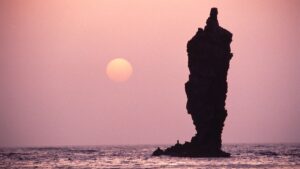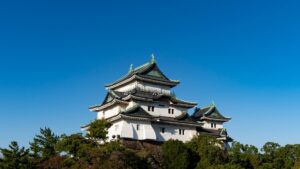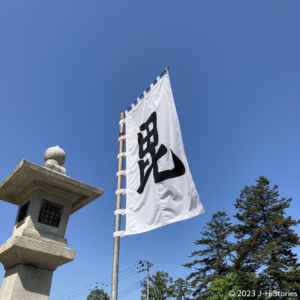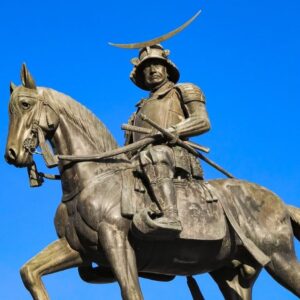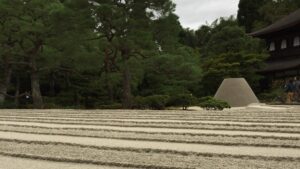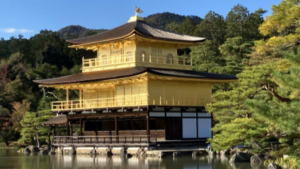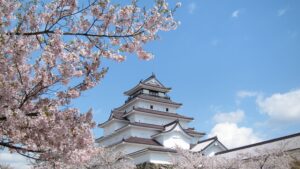The Oki Islands, The Exile of Emperor Go-Toba by Samurai: A Political Drama in Medieval Japan
A 50-minute flight from Itami Airport in Osaka, the Oki isolated Islands in Shimane Prefecture, a UNESCO World Geopark, are blessed with abundant nature. Since ancient times, the islands have been called the "Islands of the Deities." Japan's oldest books, Kojiki and Nihonshoki, describe the creation of the Oki Islands by two deities, Izanagi and […]
Yoshino Jingu Shrine and Yoshimizu Shrine: The Heart of the Southern Court, Dedicated to Emperor Go-Daigo
In spring, Mt. Yoshino is adorned with approximately 30,000 cherry blossoms in full bloom, comprising about 200 different varieties of Yamazakura, mountain cherry blossoms, gradually reach full bloom in four areas - Shimo, Naka, Kami, and Oku – ascending from the base to the summit, taking about a month to unfold fully. The panoramic view […]
Sakuradamon Gate of Edo Castle ruins with beautiful cherry blossoms: Ii Naosuke lost his life
The stunning sight of cherry blossoms in full bloom reflecting on the water of Chidorigafuchi moat of the former Edo Castle, now the Imperial Palace, is breathtaking. Its beauty leads to the Sakuradamon gate, where a startling event occurred under a cold sky with heavy snowfall in 1860 for the Tokugawa Shogunate. Ii Naosuke (1815-1860; […]
Wakayama Castle, A Great Lord, Yorinobu, laid the foundation of the Kishu's prosperity
In 1619, three years after Tokugawa Ieyasu's passing, his 10th son, Tokugawa Yorinobu (1602-1671, 徳川頼宣), received 555,000 koku, equivalent to the rice crop of yield (*) and established the Kishu domain (present-day Wakayama and southern Mie Prefectures). Wakayama Castle, the Kishu Tokugawa Family's residence, was extended and constructed at the mouth of the Kino River, […]
The God of War, Kenshin, and the Muromachi Shogunate Revival
Uesugi Kenshin (1530-1578, 上杉謙信) was a fervent believer in the god of war, Bishamonten (毘沙門天), using one of the letters of '毘' as an emblem on his own flag, and fighting under the banner of 'Bi'. During his lifetime, he lost only twice out of 71 battles, making him a true military god. During the […]
One-Eyed Dragon, Date Masamune, The Great Samurai's Legacy and Beliefs
One-Eyed Dragon, Date Masamune: The Great Samurai's Legacy and Beliefs
The history of Ginkakuji Kyoto as a moon-viewing temple
Ginkakuji Temple (Silver Pavilion), a World Heritage Site and a National Treasure is nestled amidst the serene Mt. Higashiyama, far from the bustling heart of Kyoto. Ashikaga Yoshimasa (1436-1490, 足利義政), the 8th Shogun of the Muromachi Shogunate (1336-1573), ordered its establishment during the latter years of his reign. Why did Yoshimasa enjoy the rising moon […]
Kinkakuji Temple (Golden Pavillion), Represents, from the top down, Buddhism, Samurai, and Court Nobles
Kinkakuji Temple (Golden Pavillion) - a World Heritage Site - is a reliquary hall of Rokuon-ji Temple built by the third shogun of the Muromachi Shogunate (1336-1573), Ashikaga Yoshimitsu, after handing the position of Shogun over to his son and assumed a Buddhist priest. The third floor is a Zen Buddhist monastery with several rounded […]
Cherry Blossoms and Red Leaves at Hakodate Goryokaku Fort
Goryokaku Fort (五稜郭) is Japan’s first western-style star fort located in Hakodate. The view from the top of the observatory, situated 90 meters above the ground of Goryokaku Park Tower, offers a truly spectacular sight. The iconic five-star shape, filled with approximately 1,600 cherry blossom trees in spring and adorned with vibrant autumn leaves in […]
Tsurugajo Castle in Aizu, A symbol of samurai loyalty during the Meiji restoration
Bells rang in the center of the castle town of the Aizu domain, signaling the invasion of Meiji government forces. Despite the Aizu domain's allegiance to the Tokugawa Shogunate and generations of shoguns, the castle fell under incessant bombardment. This is in contrast to the Shogun's residence, Edo Castle, which surrendered without bloodshed. Why did […]

